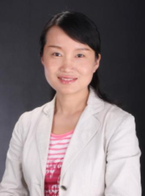Invited Speaker

Liping Feng
Professor, Northwestern Polytechnical University, ChinaSpeech Title: Preparation and Optoelectronic Properties of novel 2D BiOX semiconductors
Abstract: Two-dimensional (2D) semiconductors have great potential for application in low power, high-performance and flexible optoelectronic devices, such as tunnelling transistors, light-emitting diodes, photodetectors and photovoltaic cells. Recently, the novel 2D semiconductors of BiOI, BiOBr, and BiOTe have been prepared via space-confined chemical vapor deposition (SCCVD) method and the new optoelectronic devices based on BiOI, BiOBr, and BiOTe have been fabricated. Two types of synthesis mechanism are proposed for these BiOX crystals: (1) 2D nucleation and growth for BiOX sheets (bottom−up); (2) layer-by-layer oxidation and exfoliation for BiOX sheets and ribbons (up−bottom). Here, we report the synthesis of millimeter-size single-crystal 2D BiOI sheets and ribbons for the first time by using a sacrifice strategy to optimize the O2 partial pressure in an atmospheric-pressure growth system. The photodetectors based on the as-grown BiOI nanosheets demonstrate high sensitivity to 473 nm light. The Ion/Ioff ratio and detectivity of BiOI photodetectors can reach up to 1 × 105 and 8.2 × 1011 Jones at 473 nm, respectively. It is demonstrated that a moderate amount of H2O molecules in the SCCVD system greatly promote the formation of high-quality 2D BiOBr crystals because of the strong polarity of H2O molecules. The BiOBr-based photodetector was fabricated, exhibiting excellent performances with a responsivity of 12.4 A W−1 and a detectivity of 1.6×1013 Jones at 365 nm. The synthesis of nonlayered BiOTe with a 2D morphology was optimized by a machine learning (ML) strategy. The resultant 2D β-BiOTe flakes with a large domain size (∼120 μm) and ultrathin thickness (∼9.5 nm) indicate promising applications of ML in guiding the CVD synthesis of 2D nonlayered materials. Compared with the bulk BiOTe with an antiglass structure, the as grown 2D BiOTe shows a unique cation-ordering superstructure. In addition, the 2D BiOTe-based photodetector shows a prominent responsivity of 79.5 A W−1 at 375 nm. This work shows an efficient strategy for preparing 2D layered and nonlayered materials, and provides a brand-new platform to study the properties and applications of 2D materials.
Biography: Feng Liping, with a Ph.D. in engineering, is a professor and doctoral supervisor at Northwestern Polytechnical University. She obtained bachelor's, master's, and doctoral degrees from Northwestern Polytechnical University from 2001 to 2006. She received funding from the National Center for Scientific Research (CNRS) in France and went to the Department of Materials Physics at the University of Franche Comt é in France as a postdoctoral fellow from 2010 to 2011. Mainly engaged in the preparation of low dimensional nano-materials and semiconductor materials, as well as research on the design, microstructure, theoretical calculations, and other aspects of optoelectronic devices. As the project leader, She have presided over more than 20 scientific research projects, including sub projects of the National Key Research and Development Program, 5 projects of the National Natural Science Foundation of China, doctoral funding from the Ministry of Education, and key projects of the Shaanxi Provincial Natural Science Foundation. As a key member, participated in and completed national high-tech "863" projects, defense basic research projects, defense pre research projects, and the French National Center for Scientific Research (CNRS) projects. In recent years, more than 130 SCI indexed papers have been published in international important journals such as Nature Communications, Advanced Materials, Advanced Functional Materials, and Advanced Science. Authorized and publicly disclosed 11 national invention patents as the first author. Currently serving as an editorial board member for international academic journals such as Nanotechnology and Sensors. Also serving as the Vice President of Science and Technology at Jinlun Technology Co., Ltd. in Haimen City, Jiangsu Province.
